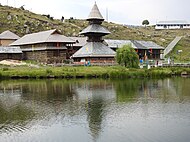
Back باغودة Arabic Pagoda AST Paqoda Azerbaijani Пагада Byelorussian Пагода Bulgarian প্যাগোডা Bengali/Bangla Pagoda Catalan Pagoda Czech Pagoda Welsh Pagode Danish

A pagoda is a tiered tower with multiple eaves common to Thailand, Cambodia, Nepal, China, Japan, Korea, Myanmar, Vietnam, and other parts of Asia. Most pagodas were built to have a religious function, most often Buddhist, but sometimes Taoist, and were often located in or near viharas. The pagoda traces its origins to the stupa, while its design was developed in ancient India.[1] Chinese pagodas (Chinese: 塔; pinyin: Tǎ) are a traditional part of Chinese architecture. In addition to religious use, since ancient times Chinese pagodas have been praised for the spectacular views they offer, and many classical poems attest to the joy of scaling pagodas.
The oldest and tallest pagodas were built of wood, but most that survived were built of brick or stone. Some pagodas are solid with no interior. Hollow pagodas have no higher floors or rooms, but the interior often contains an altar or a smaller pagoda, as well as a series of staircases for the visitor to climb to see the view from an opening on one side of each tier. Most have between three and 13 tiers (almost always an odd number) and the classic gradual tiered eaves.[2][3]
In some countries, the term may refer to other religious structures. In Vietnam and Cambodia, due to French translation, the English term pagoda is a more generic term referring to a place of worship, although pagoda is not an accurate word to describe a Buddhist vihara. The architectural structure of the stupa has spread across Asia, taking on many diverse forms specific to each region. Many Philippine bell towers are highly influenced by pagodas through Chinese workers hired by the Spaniards.
- ^ "Pagoda | History, Design & Construction | Britannica". www.britannica.com.
- ^ Architecture and Building. W.T. Comstock. 1896. p. 245.
- ^ Steinhardt, 387.





